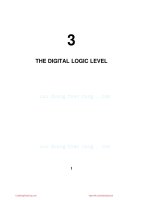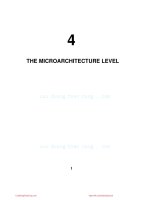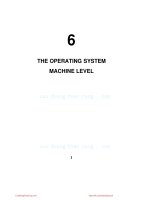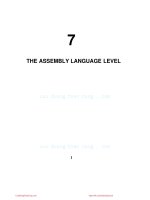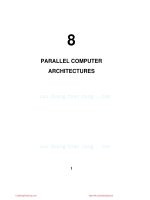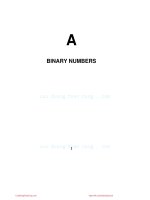kiến trúc máy tính dạng thanh tin figs 3 the digital logic level sinhvienzone com
Bạn đang xem bản rút gọn của tài liệu. Xem và tải ngay bản đầy đủ của tài liệu tại đây (242.25 KB, 58 trang )
3
THE DIGITAL LOGIC LEVEL
1
CuuDuongThanCong.com
/>
+VCC
+VCC
+VCC
Vout
V1
Collector
Vout
Vout
Vin
V2
V1
V2
Emitter
Base
(a)
(b)
(c)
Figure 3-1. (a) A transistor inverter. (b) A NAND gate. (c) A NOR gate.
CuuDuongThanCong.com
/>
NOT
A
X
A
NAND
X
B
A
0
1
X
1
0
(a)
NOR
A
X
B
A
0
0
1
1
B
0
1
0
1
(b)
X
1
1
1
0
AND
A
X
B
A
0
0
1
1
B
0
1
0
1
(c)
X
1
0
0
0
OR
A
X
B
A
0
0
1
1
B
0
1
0
1
X
0
0
0
1
(d)
A
0
0
1
1
B
0
1
0
1
X
0
1
1
1
(e)
Figure 3-2. The symbols and functional behavior for the five basic gates.
CuuDuongThanCong.com
/>
A B C
A B C
A
1
A
4
5
B
ABC
ABC
2
A
0
0
0
0
1
1
1
1
B
0
0
1
1
0
0
1
1
C
0
1
0
1
0
1
0
1
(a)
M
0
0
0
1
0
1
1
1
8
B
6
ABC
C
3
C
7
ABC
(b)
Figure 3-3. (a) The truth table for the majority function of
three variables. (b) A circuit for (a).
CuuDuongThanCong.com
/>
M
A
A
A
A
(a)
A
A
AB
A+B
B
B
A
AB
A
A+B
B
B
(b)
(c)
Figure 3-4. Construction of (a) NOT, (b) AND, and (c) OR
gates using only NAND gates or only NOR gates.
CuuDuongThanCong.com
/>
AB
A
B
AB + AC
A
A(B + C)
B
AC
C
B+C
C
A
B
C
AB
AC
AB + AC
A
B
C
A
B+C
A(B + C)
0
0
0
0
0
0
0
0
0
0
0
0
0
0
1
0
0
0
0
0
1
0
1
0
0
1
0
0
0
0
0
1
0
0
1
0
0
1
1
0
0
0
0
1
1
0
1
0
1
0
0
0
0
0
1
0
0
1
0
0
1
0
1
0
1
1
1
0
1
1
1
1
1
1
0
1
0
1
1
1
0
1
1
1
1
1
1
1
1
1
1
1
1
1
1
1
(a)
(b)
Figure 3-5. Two equivalent functions. (a) AB + AC. (b) A(B + C).
CuuDuongThanCong.com
/>
Name
AND form
OR form
Identity law
1A = A
0+A=A
Null law
0A = 0
1+A=1
Idempotent law
AA = A
A+A=A
Inverse law
AA = 0
A+A=1
Commutative law
AB = BA
A+B=B+A
Associative law
(AB)C = A(BC)
(A + B) + C = A + (B + C)
Distributive law
A + BC = (A + B)(A + C)
A(B + C) = AB + AC
Absorption law
A(A + B) = A
A + AB = A
De Morgan's law
AB = A + B
A + B = AB
Figure 3-6. Some identities of Boolean algebra.
CuuDuongThanCong.com
/>
AB
=
A+B
A+B
(a)
AB
=
(c)
=
AB
(b)
A+B
A+B
=
AB
(d)
Figure 3-7. Alternative symbols for some gates: (a) NAND. (b) NOR.
(c) AND. (d) OR.
CuuDuongThanCong.com
/>
A
A
B
XOR
0
0
0
0
1
1
1
0
1
A
1
1
0
B
B
(a)
(b)
A
A
B
B
A
A
B
B
(c)
(d)
Figure 3-8. (a) The truth table for the XOR function. (b)-(d)
Three circuits for computing it.
CuuDuongThanCong.com
/>
A
B
F
A
B
F
A
B
F
0V
0V
0V
0
0
0
1
1
1
0V
5V
0V
0
1
0
1
0
1
5V
0V
0V
1
0
0
0
1
1
5V
5V
5V
1
1
1
0
0
0
(a)
(b)
(c)
Figure 3-9. (a) Electrical characteristics of a device.
(b) Positive logic. (c) Negative logic.
CuuDuongThanCong.com
/>
VCC
14
13
12
11
10
9
8
1
2
3
4
5
6
7
Notch
GND
Figure 3-10. An SSI chip containing four gates.
CuuDuongThanCong.com
/>
Pin 8
D0
D1
D2
D3
F
D4
D5
D6
D7
A A B B C C
A
B
C
Figure 3-11. An eight-input multiplexer circuit.
CuuDuongThanCong.com
/>
VCC
D0
D0
D1
D1
D2
D2
D3
F
D4
D3
D5
D5
D6
D6
D7
D7
A B C
(a)
F
D4
A B C
(b)
Figure 3-12. (a) An MSI multiplexer.. (b) The same multiplexer wired to compute the majority function.
CuuDuongThanCong.com
/>
D0
D1
A
B
A
D2
A
D3
B
D4
B
C
D5
C
C
D6
D7
Figure 3-13. A 3-to-8 decoder circuit.
CuuDuongThanCong.com
/>
EXCLUSIVE OR gate
A0
B0
A1
B1
A=B
A2
B2
A3
B3
Figure 3-14. A simple 4-bit comparator.
CuuDuongThanCong.com
/>
A
If this fuse is
blown, B is not
an input to AND
gate 1.
B
12 ϫ 2 = 24
input signals
L
24 input lines
0
1
49
0
1
6 outputs
If this fuse is
blown, AND gate
1 is not an input
to OR gate 5.
50 input
lines
5
Figure 3-15. A 12-input, 6-output programmable logic array.
The little squares represent fuses that can be burned out to
determine the function to be computed. The fuses are arranged
in two matrices: the upper one for the AND gates and the lower
one for the OR gates.
CuuDuongThanCong.com
/>
D0
D1
D2
D3
D4
D5
D6
D7
S0
S1
S2
S3
S4
S5
S6
S7
C
Figure 3-16. A 1-bit left/right shifter.
CuuDuongThanCong.com
/>
Exclusive OR gate
A
B
0
0
0
0
0
1
1
0
1
0
1
0
1
1
0
1
Sum Carry
A
Sum
B
Carry
Figure 3-17. (a) Truth table for 1-bit addition. (b) A circuit for a half adder.
CuuDuongThanCong.com
/>
Carry in
Carry
Carry
Sum
in
out
A
B
0
0
0
0
0
0
0
1
1
0
0
1
0
1
0
0
1
1
0
1
1
0
0
1
0
1
0
1
0
1
1
1
0
0
1
1
1
1
1
1
A
Sum
B
Carry out
(a)
(b)
Figure 3-18. (a) Truth table for full adder. (b) Circuit for a full adder.
CuuDuongThanCong.com
/>
Logical unit
Carry in
AB
INVA
A
ENA
B
ENB
A+B
Output
B
Sum
Enable
lines
F0
Full
adder
F1
Decoder
Carry out
Figure 3-19. A 1-bit ALU.
CuuDuongThanCong.com
/>
F1 F0
A7 B7
A6 B6
A5 B5
A4 B4
A3 B3
A2 B2
A1 B1
A0 B0
1-bit
ALU
1-bit
ALU
1-bit
ALU
1-bit
ALU
1-bit
ALU
1-bit
ALU
1-bit
ALU
1-bit
ALU
O7
O6
O5
O4
O3
O2
O1
O0
Carry
in
Carry
out
Figure 3-20. Eight 1-bit ALU slices connected to make an 8bit ALU. The enables and invert signals are not shown for simplicity.
CuuDuongThanCong.com
/>
INC
C1
Delay
C2
(a)
(b)
A
B
C
(c)
Figure 3-21. (a) A clock. (b) The timing diagram for the
clock. (c) Generation of an asymmetric clock.
CuuDuongThanCong.com
/>
S
0
1
Q
S
0
0
Q
1
1
R
0
0
0
0
(a)
Q
R
1
0
Q
A
B
NOR
0
0
1
0
1
0
1
0
0
1
1
0
(b)
(c)
Figure 3-22. (a) NOR latch in state 0. (b) NOR latch in state 1.
(c) Truth table for NOR.
CuuDuongThanCong.com
/>
S
Q
Clock
Q
R
Figure 3-23. A clocked SR latch.
CuuDuongThanCong.com
/>
D
Q
Q
Figure 3-24. A clocked D latch.
CuuDuongThanCong.com
/>


